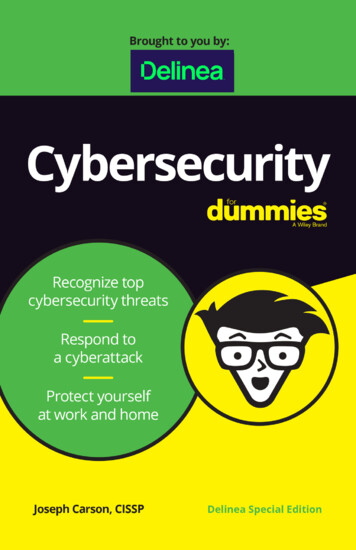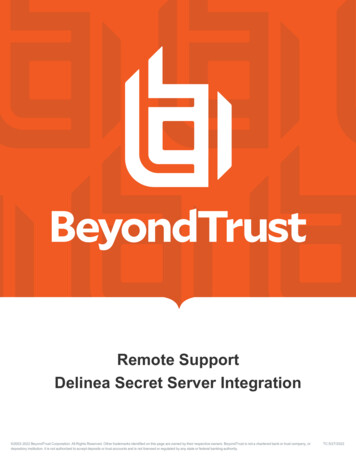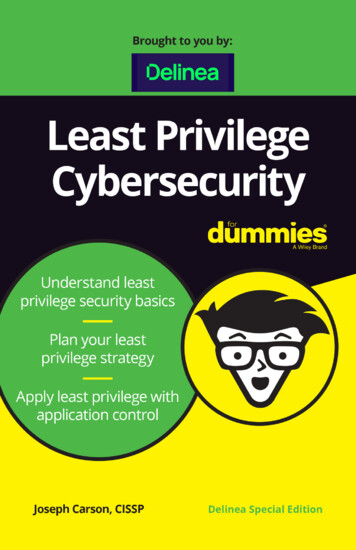
Transcription
About DelineaDelinea is a leading provider of privileged access management (PAM) solutionsfor the modern, hybrid enterprise and makes privileged access more accessibleby eliminating complexity, enforcing Zero Trust, and seamlessly defining theboundaries of access. Delinea simplifies security, ensures compliance andreduces risk for thousands of customers, over half the Fortune 100, and theworld’s largest financial institutions, intelligence agencies and criticalinfrastructure companies. For more information, go to www.delinea.com
CybersecurityDelinea Special Editionby Joseph Carson, CISSPThese materials are 2022 John Wiley & Sons, Inc. Any dissemination, distribution, or unauthorized use is strictly prohibited.
Cybersecurity For Dummies , Delinea Special EditionPublished byJohn Wiley & Sons, Inc.111 River St.Hoboken, NJ 07030-5774www.wiley.comCopyright 2022 by John Wiley & Sons, Inc. Hoboken, New Jersey.No part of this publication may be reproduced, stored in a retrieval system or transmitted in anyform or by any means, electronic, mechanical, photocopying, recording, scanning or otherwise,except as permitted under Sections 107 or 108 of the 1976 United States Copyright Act, withoutthe prior written permission of the Publisher. Requests to the Publisher for permission should beaddressed to the Permissions Department, John Wiley & Sons, Inc., 111 River Street, Hoboken, NJ07030, (201) 748-6011, fax (201) 748-6008, or online at http://www.wiley.com/go/permissions.Trademarks: Wiley, For Dummies, the Dummies Man logo, The Dummies Way, Dummies.com,Making Everything Easier, and related trade dress are trademarks or registered trademarks ofJohn Wiley & Sons, Inc. and/or its affiliates in the United States and other countries, and may notbe used without written permission. Delinea and the Delinea logo are trademarks of Delinea. Allother trademarks are the property of their respective owners. John Wiley & Sons, Inc., is notassociated with any product or vendor mentioned in this book.LIMIT OF LIABILITY/DISCLAIMER OF WARRANTY: WHILE THE PUBLISHER AND AUTHORS HAVEUSED THEIR BEST EFFORTS IN PREPARING THIS WORK, THEY MAKE NO REPRESENTATIONSOR WARRANTIES WITH RESPECT TO THE ACCURACY OR COMPLETENESS OF THE CONTENTS OFTHIS WORK AND SPECIFICALLY DISCLAIM ALL WARRANTIES, INCLUDING WITHOUT LIMITATIONANY IMPLIED WARRANTIES OF MERCHANTABILITY OR FITNESS FOR A PARTICULAR PURPOSE.NO WARRANTY MAY BE CREATED OR EXTENDED BY SALES REPRESENTATIVES, WRITTEN SALESMATERIALS OR PROMOTIONAL STATEMENTS FOR THIS WORK. THE FACT THAT AN ORGANIZATION,WEBSITE, OR PRODUCT IS REFERRED TO IN THIS WORK AS A CITATION AND/OR POTENTIAL SOURCEOF FURTHER INFORMATION DOES NOT MEAN THAT THE PUBLISHER AND AUTHORS ENDORSETHE INFORMATION OR SERVICES THE ORGANIZATION, WEBSITE, OR PRODUCT MAY PROVIDEOR RECOMMENDATIONS IT MAY MAKE. THIS WORK IS SOLD WITH THE UNDERSTANDING THATTHE PUBLISHER IS NOT ENGAGED IN RENDERING PROFESSIONAL SERVICES. THE ADVICE ANDSTRATEGIES CONTAINED HEREIN MAY NOT BE SUITABLE FOR YOUR SITUATION. YOU SHOULDCONSULT WITH A SPECIALIST WHERE APPROPRIATE. FURTHER, READERS SHOULD BE AWARETHAT WEBSITES LISTED IN THIS WORK MAY HAVE CHANGED OR DISAPPEARED BETWEEN WHENTHIS WORK WAS WRITTEN AND WHEN IT IS READ. NEITHER THE PUBLISHER NOR AUTHORSSHALL BE LIABLE FOR ANY LOSS OF PROFIT OR ANY OTHER COMMERCIAL DAMAGES, INCLUDINGBUT NOT LIMITED TO SPECIAL, INCIDENTAL, CONSEQUENTIAL, OR OTHER DAMAGES.For general information on our other products and services, or how to create a custom For Dummiesbook for your business or organization, please contact our Business Development Department inthe U.S. at 877-409-4177, contact info@dummies.biz, or visit www.wiley.com/go/custompub.For information about licensing the For Dummies brand for products or services, contactBrandedRights&Licenses@Wiley.com.ISBN: 978-1-119-88720-1 (pbk); ISBN: 978-1-119-88721-8 (ebk). Some blank pages in the printversion may not be included in the ePDF version.Publisher’s AcknowledgmentsSome of the people who helped bring this book to market include the following:Project Manager:Carrie Burchfield-LeightonSr. Managing Editor: Rev MengleAcquisitions Editor: Ashley CoffeyBusiness DevelopmentRepresentative: Matt CoxProduction Editior:Mohammed Zafar AliThese materials are 2022 John Wiley & Sons, Inc. Any dissemination, distribution, or unauthorized use is strictly prohibited.
IntroductionThe issues and challenges associated with cybersecurity — themeasures taken to protect computer systems against unauthorized access or attack — come up almost daily in yourwork and home lives these days. Media headlines highlight thelatest breaches of confidential information, exposing millions ofpersonal information records. Executives lose their jobs becauseof these incidents. Companies sometimes see a sudden drop intheir stock market value. Others must pay a “ransom” to get theirhijacked information back. And for smaller organizations, theirvery existence as a business may be threatened.Despite billions of dollars spent each year on sophisticated technology to help protect critical information assets, malicioushackers and insiders continue to steal information with seemingimpunity. The vast majority of breaches in cybersecurity are theresult of human errors or actions that often occur without peopleeven being aware of what they have done.Technology alone can’t protect your identity or sensitive information. Malicious hackers and other threat actors target humans,seeking ways to trick them into giving up vital informationunknowingly. They do this because it’s the easiest way to getat valuable data in a process known as social engineering. So, it’snot surprising that exploited humans are the weakest link in thecybersecurity chain and yet the best hope for preventing a cybersecurity disaster.About This BookCybersecurity For Dummies, Delinea Special Edition, helps youunderstand and recognize the most common cybersecurity threatspeople face daily in their personal and work lives. With that understanding, you can then begin to adopt good cyber hygiene thathelps you avoid becoming the next victim. Spending a few minutes reading this book also helps you learn how cybercriminalstarget their victims, what you can do to reduce your risk, and howyou can personally make it much more difficult for the attackersto steal your information, your identity, and your money.Introduction1These materials are 2022 John Wiley & Sons, Inc. Any dissemination, distribution, or unauthorized use is strictly prohibited.
Icons Used in This BookThis book uses the following icons to indicate special content.You don’t want to forget this information. It’s essential to gaina basic understanding of cybersecurity threats and how to detectthem.The Tip icon points out practical advice that saves you time andeffort in improving your own cybersecurity hygiene, and thisinformation also helps you avoid getting cyber fatigue and reducesyour risk of being a victim of cybercrime.Watch out! Pay close attention to these details. They focus onserious issues that have a major impact on you and your organization’s security.Beyond the BookBecause cybersecurity is literally everywhere in your always-on,Internet-connected lives, you need to get on board with recognizing that the more you learn about how to protect yourself, theeasier and safer your life will be. But your learning can’t stop withchanging a few passwords or taking a few tips from this book. Youshould continually educate yourself.Many online safety awareness campaigns exist that offer practical, up-to-date advice on how you can stay safer and more secureonline. I recommend the following two:»» www.cisa.gov/cybersecurity-awareness-month»» iamcybersafe.org/s2Cybersecurity For Dummies, Delinea Special EditionThese materials are 2022 John Wiley & Sons, Inc. Any dissemination, distribution, or unauthorized use is strictly prohibited.
IN THIS CHAPTER»» Targeting humans as the primary causeof breaches»» Fighting cyber fatigueChapter1Cybersecurity IsEveryone’s ResponsibilityIn our always-connected world where the private information ofindividuals and organizations is vulnerable to exposure andmisuse, cybersecurity is everyone’s responsibility because malicious hackers or threat actors who steal proprietary informationdon’t care about age, gender, race, culture, beliefs, or nationality.They probe your digital footprint and your Internet-connectedcomputers based on opportunity, often seeking financial gain.Targeting HumansPeople are the top target and cause of cybersecurity failuresbecause most of them are trusting individuals who want to helpor contribute as part of human nature and their jobs. Malicioushackers and insiders take advantage of that trust by appearing tomake legitimate business requests from bosses or sharing socialitems of a more personalized nature. They’re counting on people’s curiosity and willingness to cooperate to get them to “clickon the link” in a business or personal email.CHAPTER 1 Cybersecurity Is Everyone’s Responsibility3These materials are 2022 John Wiley & Sons, Inc. Any dissemination, distribution, or unauthorized use is strictly prohibited.
One single click on a malicious link, however, can download malware onto your computer that can immediately lock up data in a“ransomware” attack, and oftentimes, you have to send moneyto regain access. Or, the downloaded malware can, unknowinglyto the user, begin instantly collecting information aimed at gaining credentials and passwords for exploiting later. While manyof these actions by humans are accidental or not intended tobe harmful, the result can cause considerable damage to themselves, their family, their co-workers, their company, and theircommunity.Malicious hackers want to stealyour identity and credentialsAs the use of the Internet and social media have grown, cybercriminals have changed the techniques they use to target people.Email continues to be the number one weapon of choice, followedby infected websites, social media scams, and stealing digitalidentities and passwords.Recent research shows that up to 80 percent of all data breachesinvolve compromising an employee’s credentials. In one survey,hackers claim that stealing an employee’s password is the fastest (and most preferred) way to breach and bypass a company’scybersecurity controls.As you connect to online services to get the latest news, shopfor the best deals, chat with friends, stream music and videos,and conduct banking transactions, you quickly become a targetof cybercriminals. Using social media, for example, you typically share a lot of personal identifiable information about yourphysical and digital identities. This info includes full name, homeaddress, telephone numbers, IP address, biometric details, location details, date of birth, birthplace, and info on other familymembers. Cybercriminals know this and can spend up to 90 percent of their time performing reconnaissance by using onlinesocial media sources to apply advanced search techniques andspecialized search engine parameters to uncover confidentialinformation from companies and individuals that doesn’t typically show up during normal web searches.4Cybersecurity For Dummies, Delinea Special EditionThese materials are 2022 John Wiley & Sons, Inc. Any dissemination, distribution, or unauthorized use is strictly prohibited.
Malicious hackers are specifically looking to steal your usernameand password credentials so they can access your information andimpersonate as you. And, when your identity is stolen, an attackercan easily bypass the traditional technical security perimeter controls without being detected. Once inside the computer network,cybercriminals can carry out malicious attacks or access and stealconfidential information by posing as a legitimate user.Your work and personal info areall linked in cyberspaceThe protection of information about both your work and personallife can no longer be separated. The frequent and pervasive useof social media networks, working from home or when traveling,and the Internet of Things (IoT) connecting all kinds of householddevices means that cybersecurity is no longer just the responsibility of your company IT department. A compromised personalaccount can easily lead a cybercriminal to discover enough information about you to make hacking your business email so mucheasier.As the line between business and personal Internet use continuesto blur, every employee must contribute in protecting informationassets at work and at home.Standing on the FrontlineMany folks at work and home suffer from cyber fatigue, whichdescribes the frustration experienced in juggling scores of onlineaccounts with multiple passwords needed to gain access to theinformation you use daily or hourly. In some cases, individualsfeel so frustrated that they give up trying to manage things safelyand default to using the same passwords for multiple accounts,sharing passwords with family members, and logging in to theInternet using their social media accounts.You are the frontline in the battle to keep information secure.Attacks rely on your goodwill and trust to succeed, so you mustbecome more personally responsible in how you manage yourinformation, and this can be tiring.CHAPTER 1 Cybersecurity Is Everyone’s Responsibility5These materials are 2022 John Wiley & Sons, Inc. Any dissemination, distribution, or unauthorized use is strictly prohibited.
To overcome cyber fatigue (or to avoid it all together), I suggestfollowing these tips:»» Simplify your logon experience by using a password managerthat will help reduce the pain of selecting long complexpasswords, remembering too many passwords, and choosing unique passwords for each account. A password managerwill do this for you.»» Set your programs, applications, and security software toautomatically update so you don’t have to manually do it.One of the most important steps in cybersecurity is stayingup to date, and enabling auto updates helps you so youdon’t have to worry about getting the latest security patches.»» Schedule data backups to ensure that when bad thingshappen you always have a solid backup to get back on trackand not get stressed out about losing important data.»» Stay educated on the latest security trends so you knowwhat’s important and can help avoid information overloadabout not knowing what’s happening in cyberspace.6Cybersecurity For Dummies, Delinea Special EditionThese materials are 2022 John Wiley & Sons, Inc. Any dissemination, distribution, or unauthorized use is strictly prohibited.
IN THIS CHAPTER»» Identifying different email scams»» Looking at the risks in social media»» Checking activity logs, mobile usage, andbandwidth»» Being leery of public Wi-FiChapter2Recognizing TopCybersecurity ThreatsCybercriminals utilize an expanding set of online tools andservices available with hacking as a service, distributeddenial of service (DDoS), and the latest ransomware as aservice. This means attackers no longer require any deep technical knowledge to carry out their attacks — they just need a laptopand an Internet connection. So you’ll be targeted now more thanever, and you must be prepared.Cybersecurity incidents are typically classified in three categories:»» Access or loss of sensitive or personal information — knownas impacting confidentiality»» Possible modification of sensitive or personal information —known as compromising integrity»» Destruction or loss of availability to sensitive or personalinformation — known as reducing availabilityThe type of cyber incident determines what actions and stepsshould be taken to minimize the impact or damage from theincident.In this chapter, I give you techniques to identify the main cybersecurity threats. In Chapter 3, I tell you how to respond.CHAPTER 2 Recognizing Top Cybersecurity Threats7These materials are 2022 John Wiley & Sons, Inc. Any dissemination, distribution, or unauthorized use is strictly prohibited.
RansomwareIf you have a ransomware attack, you know almost immediatelybecause you see a message from the cybercriminal that your fileshave been encrypted or that you have been locked out of yourcomputer. Note that it’s common to see mistakes in spelling andformatting in these types of messages. This message can looksimilar to Figure 2-1. You will then be asked to pay a ransom toget an encryption key and restore your files. Payment is typicallydemanded in Bitcoins or some other well-known cryptocurrency.FIGURE 2-1: A typical ransomware message.If you see such a message, it’s vital that you make sure it doesn’tspread to other devices at work or at home. Disconnect the infectedcomputer from the Internet or your company network. Removethe network cable, turn off Wi-Fi, and power off your device. Ifit occurs on a company computer or occurs on your company’snetwork, immediately notify your IT department.Email ThreatsEmail continues to be the most popular weapon of choice when itcomes to stealing credentials, installing malware, or locking upinformation in a ransomware attack. Cybercriminals prefer emailbecause all it takes is for one victim to open an attachment in anemail or click on a link to open the door for attackers to exploit.8Cybersecurity For Dummies, Delinea Special EditionThese materials are 2022 John Wiley & Sons, Inc. Any dissemination, distribution, or unauthorized use is strictly prohibited.
Spam emailsSpam emails show some personal information and can look veryauthentic so you must examine them all carefully. While spamfilter technologies do a better job at screening threats, spammers are getting better at incorporating authentic details, including already disclosed or stolen personal information, that enablethem to get through into your email inbox.One simple method used by cybercriminals to capture information about what device and browser you use, software versions,patch levels, and more features an HTML email sent to you witha tiny image similar to the example in Figure 2-2. Simply clicking on this email will download the image automatically into youremail client by default unless you change your settings. And indownloading that image you share information that cybercriminals can use to exploit your systems.To prevent sharing information about your device and location,make sure to disable automatic image downloads in your emailclient. That way you control when to download images fromincoming email.FIGURE 2-2: An example warning message when image is included.Phishing emailsPhishing emails often contain personal information and can bevery authentic looking, typically pretending to be a legitimate service from a known vendor. Phishing emails almost always pose asan urgent message from an authority that requires a quick action,such as clicking a link or opening an attached file to avoid furthertrouble, late fees, and so on. These emails normally contain multiple hyperlinks — some are legitimate to disguise the one malicious link among them — and may contain spelling errors (in thisexample, judgement versus judgment and plantiff versus plaintiff).You can see an example of this type of email in Figure 2-3.CHAPTER 2 Recognizing Top Cybersecurity Threats9These materials are 2022 John Wiley & Sons, Inc. Any dissemination, distribution, or unauthorized use is strictly prohibited.
FIGURE 2-3: A phishing email example with highlighted indicators of threats.Do not open or click on any suspicious link or attachment becausethis could corrupt your system and give cybercriminals access toall your data.Cybercriminals intelligently comb through public social data,searching for victims that are easy targets and will yield thequickest access. They collect info to form a digital footprint ofpotential victims, hoping they will be tricked into revealing moresensitive information including account passwords, access toemail, or even full control of devices.Watch out if the email display name doesn’t match the emailaddress of the sender or if the attachment has a random soundingname, or if the hyperlink display names don’t match the actualURL of the attachment. Simply hover your mouse over the link toreveal the real URL address, but do not click the link. These threatsare also becoming more popular on social media and messagingapplications that are very difficult to tell the difference — sometimes only containing a single character difference — sowatch out for these threats via messenger applications.Just like with known spam, mark the senders of your suspectedphishing emails as junk or spam, and report them immediately toyour IT Security department if they appear directly in your workinbox. Don’t forward a phishing email. Make sure you’ve takenbasic steps to protect your devices and scanned your system andemails for malware.10Cybersecurity For Dummies, Delinea Special EditionThese materials are 2022 John Wiley & Sons, Inc. Any dissemination, distribution, or unauthorized use is strictly prohibited.
Spear phishing emailsSpear phishing emails target you personally, pretending to befrom someone you know and trust, such as a friend, colleague,or boss. They contain a hyperlink or attachment, such as a PDF,Word document, Excel spreadsheet, or PowerPoint presentation.The most frequent spear phishing attacks appear to come fromyour employer’s executive management team or someone inauthority requesting you to perform an important action — eitheropening an attachment or in some cases an urgent transfer ofmoney to a link in the email.Limit what you share on social media, and enable privacy andsecurity settings on your Facebook, Twitter, or other socialaccounts. Don’t accept “friend” requests unless you know theperson well.Social Media ThreatsSocial media and their associated social usernames and passwords have become part of everyday life. While email is still thepreferred tool for cybercriminals, social media has become morepopular because when you create social media accounts, youopen the details of your life to cybercriminals searching for personal information. Social media accounts continuously ask youto provide more details about your date of birth, location, phonenumber(s), workplace, education, home town, and family members. They want this information to target you for personalizedfeeds, custom preferences, and advertisements and to help connect you with people, events, or groups that fit your interests.On social media, limit your Personal Identifiable Information(PII), which is information such as your mobile number or homeaddress. Whenever using or creating a new social media account,only enter the basic information required to get the accountactivated. Avoid the temptation to add more details. If you’ve already added this information, change your settings to hidden/private or remove them from your profile.CHAPTER 2 Recognizing Top Cybersecurity Threats11These materials are 2022 John Wiley & Sons, Inc. Any dissemination, distribution, or unauthorized use is strictly prohibited.
As you create more online accounts, social media accounts offerthemselves as a single sign on, as shown in Figure 2-4, to simplify and reduce the ever-growing cyber fatigue of remembering passwords, but such convenience disguises huge risks. If yoursocial media account is compromised, a cybercriminal can easilyaccess all your other associated accounts by using that one socialmedia account password. Instead of using social logon, considerusing a password manager (details in Chapter 4).FIGURE 2-4: A single sign on offering.Cybercriminals also use social media communication and chatto send you an image or video where you’re tagged. It may evencome from another compromised friend’s account and appearlegitimate to you. When you see such messages delete, archive, orreport them and do not click on any links, images, or attachments.If the message appears to come from a friend, message or call thatperson to verify.Checking Activity LogsAn activity log lets you review and manage what you share onsocial media. Most Internet accounts and credentials record whenand where you log in to your accounts, which browser was used,what you posted, photos you get tagged in, new devices, failedlogin attempts, and much more.Get into the habit of reviewing your account activity logs. Getalerts about your logging activity through proactive notificationslike the one shown in Figure 2-5. Continuously reviewing youractivity log allows you to get familiar with your social activity, bemore cautious, and limit what you post.12Cybersecurity For Dummies, Delinea Special EditionThese materials are 2022 John Wiley & Sons, Inc. Any dissemination, distribution, or unauthorized use is strictly prohibited.
FIGURE 2-5: Setting up extra security for your logins.Enable login notifications on existing and new devices and browsers. Such notifications of unusual activity are good indicators thatyour account has been compromised and is now being abused.Also, periodically check your sent emails to check for any suspicious sent email.Mobile and Bandwidth UsageUnusually high mobile data and Internet usage can indicate that adevice has been compromised and that data is being extracted andstolen. Always review your monthly Internet usage trends (typically available from your Internet service provider or your homerouter) for both downloads and uploads to monitor your monthlyInternet activity. You can typically set limits on usage that willalert you to suspicious levels. When these alarms get triggered,immediately review your usage levels.Beware of Public Wi-FiData roaming options from telecommunication companies aretypically expensive to use in making connections while you’re onthe road. So when using public Wi-Fi during travels, always makesure to use it with caution and keep the following tips in mind:»» Always assume someone is monitoring your datawhenever you use a public Wi-Fi connection. Therefore,don’t access your sensitive data, such as financial information, don’t change your passwords, and beware of enteringyour credentials. If you have a mobile device with a personalhotspot function, use this over public Wi-Fi.CHAPTER 2 Recognizing Top Cybersecurity Threats13These materials are 2022 John Wiley & Sons, Inc. Any dissemination, distribution, or unauthorized use is strictly prohibited.
»» Remove the connections after you’ve finished joining aWi-Fi network. If you don’t, you risk what’s known as a Wi-FiMan in The Middle (MITM) attack, which is a Wi-Fi hotspotthat uses common Wi-Fi names such as home, airport, café,or free Wi-Fi. When your device sees a known network, it willautomatically connect. Make sure to know what networksyou are connecting to.»» Disable the “automatically join known networks,” featureon your portable devices. That way, when connecting toWi-Fi, you’ll need to review the correct network name and seewhether it’s secure and protected. Note: On some devices thisfeature may be named slightly different, so check your usermanual.14Cybersecurity For Dummies, Delinea Special EditionThese materials are 2022 John Wiley & Sons, Inc. Any dissemination, distribution, or unauthorized use is strictly prohibited.
IN THIS CHAPTER»» Discovering you’ve been compromised»» Ransomware, infected devices, thirdparty alerts»» Notifying boss, colleagues, and friendsChapter3Responding in the Wakeof a CyberattackWith cyber threats, it’s only a matter of when and not ifyou’re going to be impacted. Some attacks are withinyour control, and some aren’t, so you need to be prepared on what to do when you do become a victim. Understandingthe method of threats you face (covered in Chapter 2) can hopefully help you identify any hack or compromise before it becomesa major incident.This chapter describes the important steps you need to follow when responding to cyberattacks. They help you reduce theimpact of any compromise, prevent it from spreading, and helpyou get back to normal operations as quickly as possible.Following Your CompanyIncident Response PlanIf your company computer or device becomes infected, you shouldfollow your company’s incident response plan and report thecyber incident as quickly as possible to the appropriate person.Many companies have corporate IT policies that define acceptableuse, password policies, rules and in some cases, incident responseCHAPTER 3 Responding in the Wake of a Cyberattack15These materials are 2022 John Wiley & Sons, Inc. Any dissemination, distribution, or unauthorized use is strictly prohibited.
procedures. Every employee should be familiar with these procedures because rapid responses tend to reduce problems or damagefrom the incident.These days, some companies have established cyber ambassadorswithin each department. These people are typically trained andIT knowledgeable and are first-line responders when somethingsuspicious occurs. This approach helps companies quickly reviewsuspicious occurrences or issues and act accordingly — much likeemergency responders.Given the frequency and evolving nature of cyber threats, everycompany should establish a well-defined and well-planned incident response process. It can mean the difference between surviving a cyberattack or losing all your data with catastrophicconsequences.Reacting to Ransomware IncidentsIf you experience a ransomware message (see Chapter 2 for moreinfo), quickly disconnect and isolate your computer from the network to protect against spreading it to other devices in your network. Remove the network cable, turn off Wi-Fi, and power off theinfected device. If the message occurs on a corporate computer,follow your company’s incident response plan for the appropriaterestore process.After a ransomware attack has succeeded, you have limitedoptions for how to respond:»» Restore your system and files from a backup.»» Start again with a fresh operating system installation andaccept that your files are gone forever.»» Pay the ransom amount, but there’s no guarantee you’l
security disaster. About This Book Cybersecurity For Dummies, Delinea Special Edition, helps you understand and recognize the most common cybersecurity threats people face daily in their personal and work lives. With that under - standing, you can then begin to adopt good cyber hygiene that helps you avoid becoming the next victim. Spending a .










